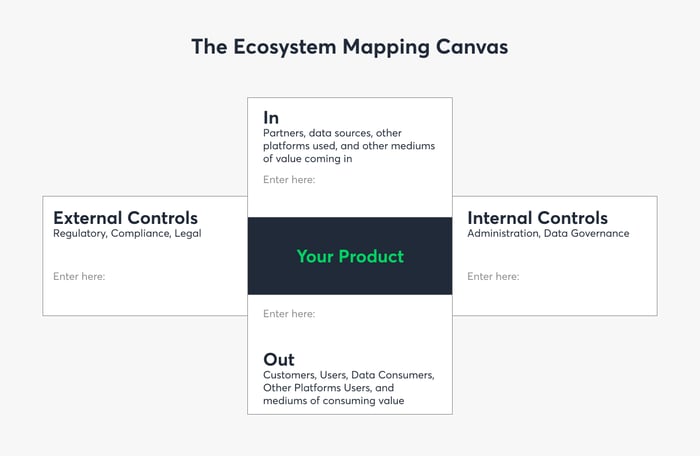Discover a Network around Your Product with Ecosystem Mapping Canvas

Understanding the wider network of collaborators, regulators, stakeholders, suppliers, as well as competitors that might significantly impact your product and business is crucial for building relationships and creating a product that solves customer problems that position right and grow in the market.
If you are interested in recognizing your product environment and different configurations and partnerships in your ecosystem, then you will benefit from Ecosystem Mapping Canvas. So, let’s get started.
A definition of Ecosystem Mapping Canvas
Ecosystem Mapping Canvas is a strategic management tool that enables everyone from product managers to sales people to gain a more realized perspective on the trajectory of their product and the environment that surrounds their product.
‘Ecosystems’ is a word that can be applied quite broadly and it can refer to new environments and industries. In most cases, a business ecosystem is a dynamic structure of interconnected and mutually dependent organizations including suppliers, partners, distributors, customers, competitors, and government agencies.
Ecosystem mapping is about understanding your micro and macro environment and putting yourself and your team in the best position to develop a product that is appropriate to your ecosystem.
Ecosystem Mapping can be useful for product management because it will expand product and sector knowledge. It is a strategy that helps realize which system your product depends on and which system depends on your product.
A variety of companies will be able to benefit from Ecosystem Mapping. Startup, scaleups, and enterprise businesses will all be able to gain a greater knowledge of their industry by mapping their ecosystem. In particular, ecosystem mapping is important for leaders working in enterprise who may often become overly-focussed on a project-centric approach and prioritize meeting commitments rather than delivering a product that properly addresses customer needs.
By instead taking a broad perspective via ecosystem mapping it is easier to develop a Minimum Viable Ecosystem. This will allow a range of participants in the product development process to learn about current and future ecosystems in a way that requires minimal effort.
How to use the Ecosystem Mapping framework?
The framework of an ecosystem mapping canvas places your product at the center and then allows you to see everything that surrounds it. This means understanding what goes into making your product, what happens after your product is delivered to consumers and how your product is controlled externally, via regulations and compliance, and internally, via administration and data governance.
The configuration of your ecosystem mapping can be customized to suit your product and business. You can then alter the framework if the product is evolving or if you want to map the ecosystem of a different product or service.
The possible categories to use in your framework include:
- In - What mediums of value come into the creation of your product? Examples include partners, data sources, other platforms, internal applications
- Out - What are the systems that act as value distributaries of your product? Examples include customers, users, data consumers, other platforms users
- Internal Controls - Here you can list all the internal systems and processes that influence the product. Examples include data governance, administration, and quality assurance. Additionally you can also list internal departments like interacting, finding/attracting and servicing customers - sales, customer support/success, BD, decision makers, internal stakeholders and leadership.
- External Controls - Here you can list all the external systems and processes that influence the product, including regulations, compliance and legal checks. You can also list competitors, parties that deliver, and parties that represent your solution.
These are the sorts of categories that could be used in a framework for products that have already been released but ecosystem mapping can also be used in other contexts.
For example, startups can use this framework to conceptualize and plan the stages of their development. Instead of “In, Out, Internal & External Controls”, you can understand the ecosystem your startup will be entering by having sections like “Idea, Launch, Development, Evangelists.”
Alternatively, if you are at the design phase within the product life cycle you can have a framework that includes sections like “The Subject, Dimensions, Aspects, Parties”.
It’s useful to illustrate the relationship between particular parties such as the flow of money from one party to another, the flow of goods and services, and the flow of information from one party to another. It is important to prioritize your most important relationships and highlight where your opportunities might be.

Benefits of using Ecosystem Mapping Canvas
Now the practical elements of Ecosystem Mapping are clear, it is worth looking at the various benefits you enjoy if you invest in some thorough ecosystem mapping. These include:
Optimized resources allocation
An ecosystem canvas can provide you with a sophisticated knowledge of where and when you should be allocating and withdrawing resources. You will have more context to how your resources are being used and how they might better be deployed in the long term. This will ensure your product team gets the resources and the support they need during creation, strategy and delivery phases.
A visual representation of the network
Sometimes it is difficult to comprehend the size and complexity of your network. With an ecosystem canvas you can get a full view of your specific ecosystem. This will help understand the customer journey you’re trying to create, know about the other companies within your ecosystem and provide a framework for your future development.
Presents all stakeholders involved and the relationships between them
Ecosystem mapping canvas provides a holistic view of your stakeholders and allows you to put a structure in place to serve each individual stakeholder. You will be able to see the relationships within your community and understand the interests of everyone involved.
Helps to find what is missing: resources, talents, partnerships
Ecosystem mapping helps to identify areas within your organization that lack support, expertise and infrastructure.
- Where should you focus your resources in the coming months?
- Which teams could benefit from an influx of new talent?
- What new partnerships are going to accelerate your business growth and help you kickstart innovation?
Ecosystem mapping can help with all of these questions by providing you with a greater understanding of your position in the market and the areas where you need to improve.
What are the challenges of using the framework?
As with any strategic management tool there are certain challenges that can arise when using ecosystem mapping. For example, the tool will only be as useful as the information you give it. Therefore, if you provide incomplete or incorrect information about your ecosystem, a mapping canvas tool won’t be able to provide you with the most useful, or practical, perspective.
Another challenge that arises whenever you use a tool to gain a broad perspective is that you might lose track of the details. Whether you are operating a startup or a more experienced enterprise, it is important to maintain a coherent vision that can help when you are focussing on the smallest of details and when you are looking at your whole ecosystem through a single tool.
In general these challenges are fairly simple to overcome. When using ecosystem mapping, always verify the data that you use and always understand that the small details are still an integral part of the product development process.
Create a map of a whole ecosystem of your product
Ecosystem mapping is an incredibly useful tool that can be used in a variety of contexts to gain greater perspective and make improvements to processes. The canvas framework can be adjusted to ensure you are completely mapping the intended ecosystem and increase your knowledge in a number of avenues in order to build a digital product.
While there are challenges to completely understanding evolving ecosystem dynamics, an ecosystem mapping canvas is definitely one of the best tools to use if you want to enhance your knowledge and come up with innovative product ideas.


...%20hero.jpg?width=415&height=415)




